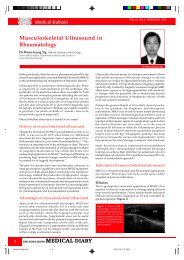MEDICAL DIARY - The Federation of Medical Societies of Hong Kong
MEDICAL DIARY - The Federation of Medical Societies of Hong Kong
MEDICAL DIARY - The Federation of Medical Societies of Hong Kong
Create successful ePaper yourself
Turn your PDF publications into a flip-book with our unique Google optimized e-Paper software.
VOL.11 VOL.14 NO.5 NO.1 MAY JANUARY 2006 2009<br />
Lipid Control for Heart Disease<br />
Dr. Tsan-fai Chan<br />
MBBS(HK), MRCP(UK), FHKCP, FHKAM(Med), FRCP(Glasg)<br />
Consultant Cardiologist, St. Teresa Hospital<br />
Coronary artery disease is the largest cause <strong>of</strong><br />
premature death in industrialised nations and is a<br />
growing threat in developing countries as well. <strong>The</strong><br />
central role <strong>of</strong> cholesterol in the pathophysiology <strong>of</strong><br />
coronary artery disease leads to lipid-lowering therapy<br />
for the medical management <strong>of</strong> this condition.<br />
Clinical research with trials using statins have<br />
demonstrated the benefits <strong>of</strong> serum cholesterol<br />
lowering in cardiovascular outcome <strong>of</strong> our population,<br />
ranging from healthy subjects to patients with overt<br />
cardiovascular risk and patients suffering from acute<br />
coronary syndrome. Our threshold <strong>of</strong> serum<br />
cholesterol lowering has been decreased as compared<br />
with the past, especially for patients with higher<br />
cardiovascular risk. Below will be a review <strong>of</strong> some <strong>of</strong><br />
the trials that can help us to look into the extent <strong>of</strong><br />
cholesterol lowering that will be beneficial to our<br />
patients.<br />
In the Heart Protection study 1, patients with a history<br />
<strong>of</strong> coronary artery disease and low-to-average total or<br />
LDL cholesterol (LDL-C) levels, persons at risk for<br />
coronary artery disease due to a history <strong>of</strong> other<br />
vascular disease (peripheral vascular disease or<br />
stroke); those who had a history <strong>of</strong> diabetes, and<br />
individuals who had been inadequately studied in the<br />
past (patients > 70 years <strong>of</strong> age, females) are studied.<br />
Between July 1994 and April 1997, 20,536 individuals<br />
were assigned to simvastatin (40 mg/day), against<br />
placebo tablets, or to a cocktail <strong>of</strong> antioxidant vitamins<br />
(600 mg vitamin E, 250 mg vitamin C, and 20 mg betacarotene)<br />
against placebo capsules, for a mean<br />
duration <strong>of</strong> at least 5 years. It was shown that subjects<br />
with LDL-C < 2.56mmol/L did benefit from further<br />
LDL-C level lowering and the risk <strong>of</strong> cardiovascular<br />
events decreased significantly in all subgroups,<br />
irrespective <strong>of</strong> baseline LDL-C<br />
<strong>The</strong> Asian population, a group that has been<br />
traditionally considered to be at much lower risk than<br />
Western counterparts; will we benefit from primary<br />
prevention with cholesterol lowering? <strong>The</strong><br />
management <strong>of</strong> elevated cholesterol in the primary<br />
prevention <strong>of</strong> adult Japanese (MEGA) trial 2 was the<br />
first large randomised trial <strong>of</strong> statins therapy in an<br />
Asian Population. <strong>The</strong> aim <strong>of</strong> the MEGA study was to<br />
evaluate the effect <strong>of</strong> cholesterol reduction with<br />
pravastatin on the incidence <strong>of</strong> cardiovascular disease<br />
in subjects with mildly elevated total cholesterol and<br />
no evidence <strong>of</strong> atherosclerotic disease and to evaluate<br />
the long-term safety <strong>of</strong> pravastatin in Japanese<br />
patients. A total <strong>of</strong> 8214 patients were randomised to<br />
<strong>Medical</strong> Bulletin<br />
Dr. Tsan-fai Chan<br />
diet or diet plus pravastatin 10-20 mg/day. All<br />
patients were advised to follow the National<br />
Cholesterol Education Program (NCEP) step 1 diet,<br />
which is low in cholesterol and saturated fats. <strong>The</strong><br />
primary endpoint <strong>of</strong> the trial, the first occurrence <strong>of</strong><br />
the CHD endpoint (fatal and nonfatal myocardial<br />
infarction [MI], angina, cardiac or sudden death, or<br />
cardiac or vascular intervention) was significantly<br />
reduced by 33% in the pravastatin group compared<br />
with the diet-alone group (P < .010) <strong>The</strong> effect <strong>of</strong><br />
pravastatin on the primary endpoint was observed<br />
early, and reached significance at 4 years. Patients<br />
having higher risks will have more benefits, including<br />
subgroups such as man > 60 years <strong>of</strong> age and baseline<br />
LDL > 4.01 mmol/L.<br />
Coronary intervention has an important role in the<br />
treatment <strong>of</strong> ischaemic heart disease, especially for<br />
patients suffering from acute coronary syndrome or<br />
acute myocardial infarction. However statins therapy<br />
is also very important as part <strong>of</strong> the medical<br />
management <strong>of</strong> this group <strong>of</strong> patients.<br />
In the PROVE IT-TIMI 22 study 3, 4162 patients with<br />
an acute coronary syndrome (ACS) within the<br />
preceding 10 days were randomly assigned in a 1:1<br />
fashion to pravastatin 40 mg or atorvastatin 80 mg<br />
daily. All patients had a total cholesterol level 6.21<br />
mmol/L but patients who were receiving long-term<br />
lipid-lowering therapy at the time <strong>of</strong> their index ACS<br />
had to have a total cholesterol level 5.18 mmol/L .<strong>The</strong><br />
primary end-point was a composite <strong>of</strong> death from any<br />
cause, myocardial infarction, documented unstable<br />
angina requiring re-hospitalisation, revascularisation<br />
(performed at least 30 days after randomisation) and<br />
stroke. <strong>The</strong> median LDL-C achieved during treatment<br />
2.46 mmol/L in the standard therapy group and 1.60<br />
mmol/L in the high-dose group (p < 0.001). Primary<br />
end-point at 2 years was 26.3% for standard therapy<br />
and 22.4% for intensive therapy, showing the benefit<br />
<strong>of</strong> intensive therapy (p = 0.005; 95% CI: 0.74-0.95).<br />
Muscle-related side effects were low and not<br />
significantly different between groups. <strong>The</strong>re were no<br />
cases <strong>of</strong> rhabdomyolysis.<br />
<strong>The</strong> Treat to New Targets/treat to new targets (TNT) 4<br />
has compared standard dose (10mg) and high dose<br />
(80mg) <strong>of</strong> atorvastatin in patients with stable coronary<br />
artery disease. It has shown that LDL-C lowering down<br />
to 2 mmol /L has further risk reduction compared with<br />
a LDL level <strong>of</strong> 2.6 mmol /L in the primary endpoint <strong>of</strong><br />
coronary heart disease death, myocardial infarction,<br />
resuscitated cardiac arrest and stroke.<br />
31

















